
Social Security’s Financial Outlook: The 2024 Update in Perspective
The brief’s key findings are:
- The 2024 Trustees Report showed a slight drop in the 75-year deficit, but the depletion date for the retirement trust fund remains at 2033.
- The prospect of a 21-percent benefit cut only 9 years away should focus our attention on restoring balance to the program.
- Further delay has real costs:
- options like investing part of the trust fund in equities are disappearing as the trust fund slides towards zero;
- the burden of tax increases or benefit cuts fully shifts to Millennials and subsequent generations; and
- waiting creates a crisis, so any fix should include automatic adjustments to restore balance so we never get in this mess again.
Introduction
The 2024 Trustees Report slightly lowered the projected 75-year deficit to 3.50 percent of taxable payroll, compared to 3.61 percent in 2023. The improvement is attributable primarily to an upward revision in the rate of productivity growth over the projection period and a further reduction in the assumed disability incidence rate. These positive developments are partially offset by a lower assumed long-term fertility rate.
The projected depletion date for the Old-Age and Survivors Insurance (OASI) trust fund assets did not change; it remains at 2033. Yes, the Disability Insurance (DI) trust fund has enough to pay benefits for the full 75-year period, so the date of depletion for the combined OASDI trust funds has moved back a year to 2035. But combining the two systems would require a change in the law; hence, under current law, the action-forcing date is 2033 – nine years from now.
This brief updates the numbers for 2024, but emphasizes that – despite the small improvement in the outlook – Congress still must act quickly to avoid draconian benefit cuts. To that end, the discussion identifies three issues: 1) options, such as investing a portion of the trust fund in equities, that disappear as the trust fund slides towards zero; 2) the increase in the burden placed on future generations as Boomers and Gen Xers avoid tax hikes or benefit cuts; and 3) so we never get in this mess again, the need to include an automatic adjustment mechanism as part of any financial package. Fixing Social Security sooner rather than later would keep more options open, distribute the burden more equitably across cohorts, and most importantly, restore confidence in the nation’s major retirement program.
The 2024 Report
Under the Trustees’ intermediate assumptions, the cost of the OASDI program rises rapidly from 14.7 percent of taxable payrolls today to 16.3 percent in 2040, drifts up to about 18.6 percent in 2080, and then declines slightly (see Figure 1).

The increase in costs is driven by demographics, specifically the drop in the total fertility rate after the Baby Boom (those born between 1946 and 1964). Women of childbearing age in 1964 had an average of 3.2 children; by 1974 that number had dropped to 1.8. The combined effects of the retirement of Baby Boomers and a slow-growing labor force due to the decline in fertility reduce the ratio of workers to retirees from about 3:1 to 2:1 and raise costs commensurately. The increasing gap between the income and cost rates means that the system is facing a 75-year deficit.
The 75-year cash flow deficit is mitigated in the short term by the assets in the trust fund, which currently equal about two years of benefits. These assets are the result of annual surpluses due to reforms enacted in 1983. Since 2010, however, when Social Security’s cost rate started to exceed the income rate, the government has been tapping the interest on trust fund assets to cover benefits. And, in 2021, as taxes and interest fell short of annual benefits, the government started to draw down trust fund assets. These drawdowns will continue until the OASI trust fund is depleted in 2033.
It is crucial to emphasize that the depletion of the trust fund does not mean that OASI has run out of money. At the time of the depletion, payroll tax revenues keep rolling in and can cover 79 percent of currently legislated benefits, declining to 71 percent by the end of the projection period. (If the OASI and DI trust funds were merged, the coverage numbers would be 83 percent, declining to 73 percent.) Relying only on current tax revenues, however, means that the replacement rate – retirement benefits relative to pre-retirement earnings – for the typical age-65 worker would drop immediately from about 36 percent to about 29 percent – a level not seen since the 1950s (see Figure 2). (Note that the replacement rate for those claiming at 65 has already declined due to the rise in the Full Retirement Age from 65 to 67.)
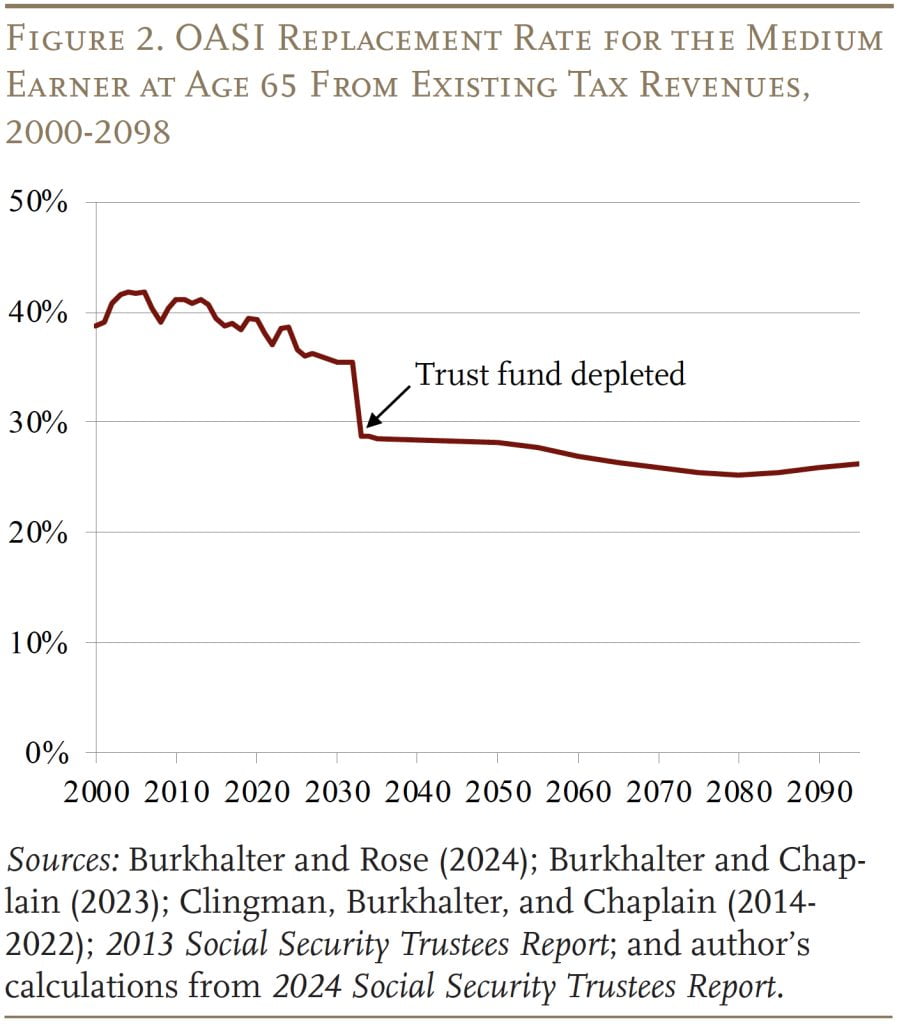
Moving from cash flows to the 75-year deficit requires calculating the difference between the present discounted value of scheduled benefits and the present discounted value of future taxes plus the assets in the trust fund. This calculation for the OASDI program shows that Social Security’s long-run deficit is projected to equal 3.50 percent of covered payroll earnings. That figure means that if payroll taxes were raised immediately by 3.50 percentage points – 1.75 percentage points each for the employee and the employer – the government could pay scheduled benefits through 2098, with a one-year reserve at the end.
At this point, solving the 75-year funding gap is not the end of the story in terms of required tax increases. In the future, once the ratio of retirees to workers stabilizes and costs remain relatively constant as a percentage of payroll, any solution that solves the problem for 75 years will more or less solve the problem permanently. But, during this period of transition, any package of policy changes that restores balance only for the next 75 years will show a deficit in the following year as the projection period picks up a year with a large negative balance. Thus, eliminating the 75-year shortfall should be viewed as the first step toward “sustainable solvency.”
Some commentators cite Social Security’s financial shortfall over the next 75 years in terms of dollars – $22.6 trillion (see Table 1). Although this number appears very large, the economy – and, therefore, taxable payrolls – will also be growing. Thus, the scary $22.6 trillion can be eliminated – and a one-year reserve created – simply by raising the payroll tax by 3.5 percentage points.
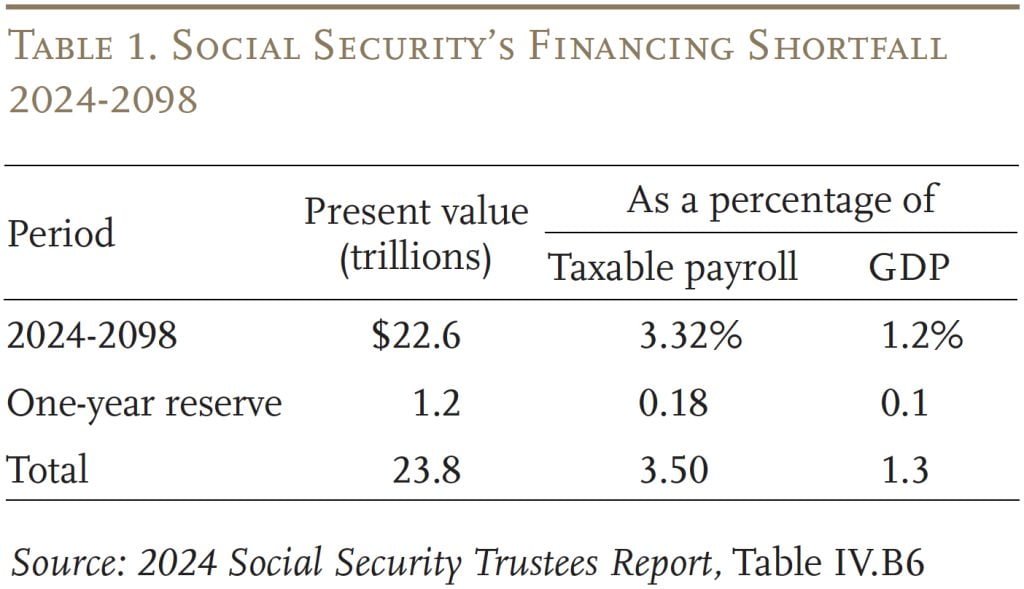
The Trustees also report Social Security’s shortfall as a percentage of GDP. The cost of the program is projected to rise from about 5 percent of GDP today to about 6 percent of GDP as the Baby Boomers retire (see Figure 3). The reason why costs as a percentage of taxable payroll keep rising – while costs as a percentage of GDP more or less stabilize – is that taxable payroll is projected to decline as a share of total compensation due to continued growth in health benefits.

2024 Report in Perspective
The 75-year deficits in the last four Trustees Reports are the largest since 1983 when Congress enacted major legislation to restore balance (see Figure 4). The main question is why did the deficit grow over the period 1983-2024, and a secondary question is why did it decline slightly since last year’s Report.

Changes in 75-Year Deficit Since 1983
Social Security moved from a projected 75-year actuarial surplus of 0.02 percent of taxable payroll in the 1983 Report to a projected deficit of 3.50 percent in the 2024 Report. As shown in Table 2, leading the list of reasons is advancing the valuation period. Each time it moves out one year, it picks up a year with a large negative balance. The cumulative effect over the last 41 years has been to increase the 75-year deficit by 2.38 percent of taxable payrolls. That is, more than two-thirds of the 41-year change in the OASDI deficit is attributable to simply moving the valuation period forward.
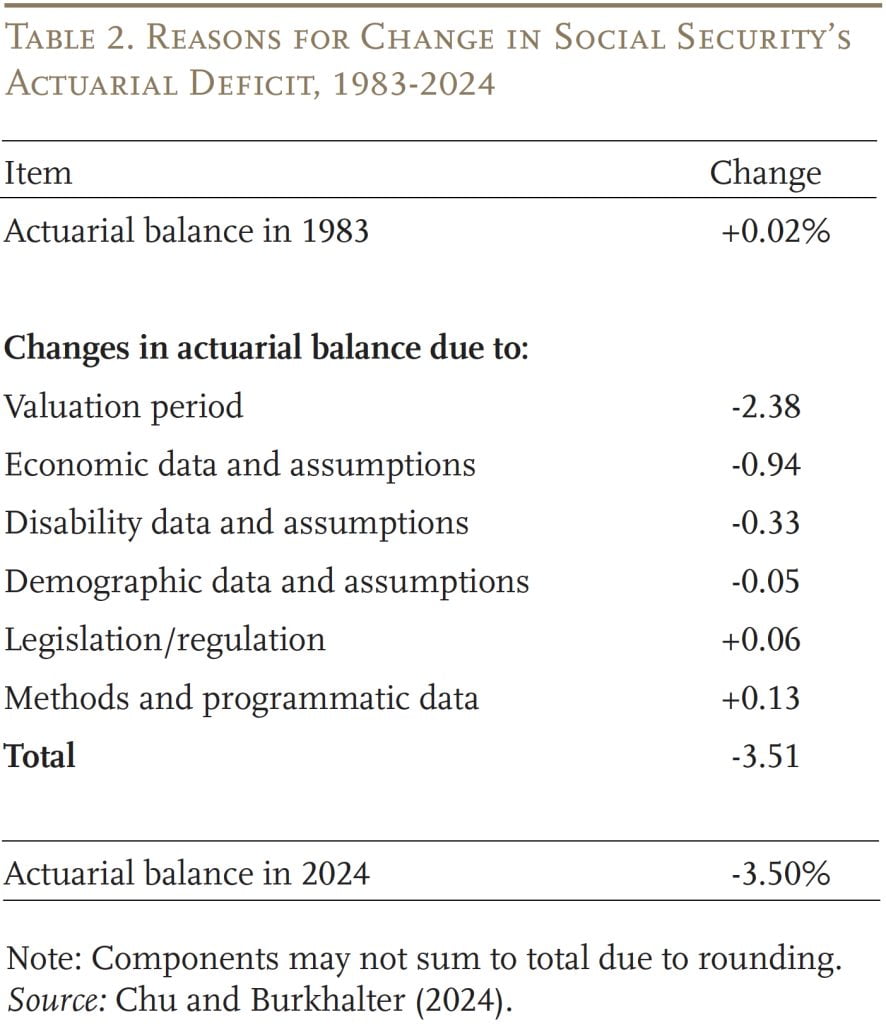
A worsening of economic assumptions – primarily a decline in assumed productivity growth and the impact of the Great Recession – have also contributed to the rising deficit. Another contributor over the past 41 years has been increases in disability rolls, although that picture has changed dramatically in recent years. Finally, changing demographic assumptions – most particularly, the reduction in the assumed fertility rate this year – has also added to the 41-year change.
Partially offsetting the negative factors has been a reduction in the actuarial deficit due to: 1) legislative and regulatory changes and 2) methodological improvements and updated data. The net effect in 2024 of all these changes is a 75-year deficit equal to 3.50 percent of taxable payrolls.
Changes from Last Year’s Report
The 3.50 percent of taxable payrolls in the 2023 Report is slightly lower than the 3.61 percent in last year’s Report (see Figure 5). This shift is primarily a result of changes in three assumptions – the economy, disability incidence, and fertility. The first two improve the long-term financial outlook, while the change in the fertility assumption worsened it.
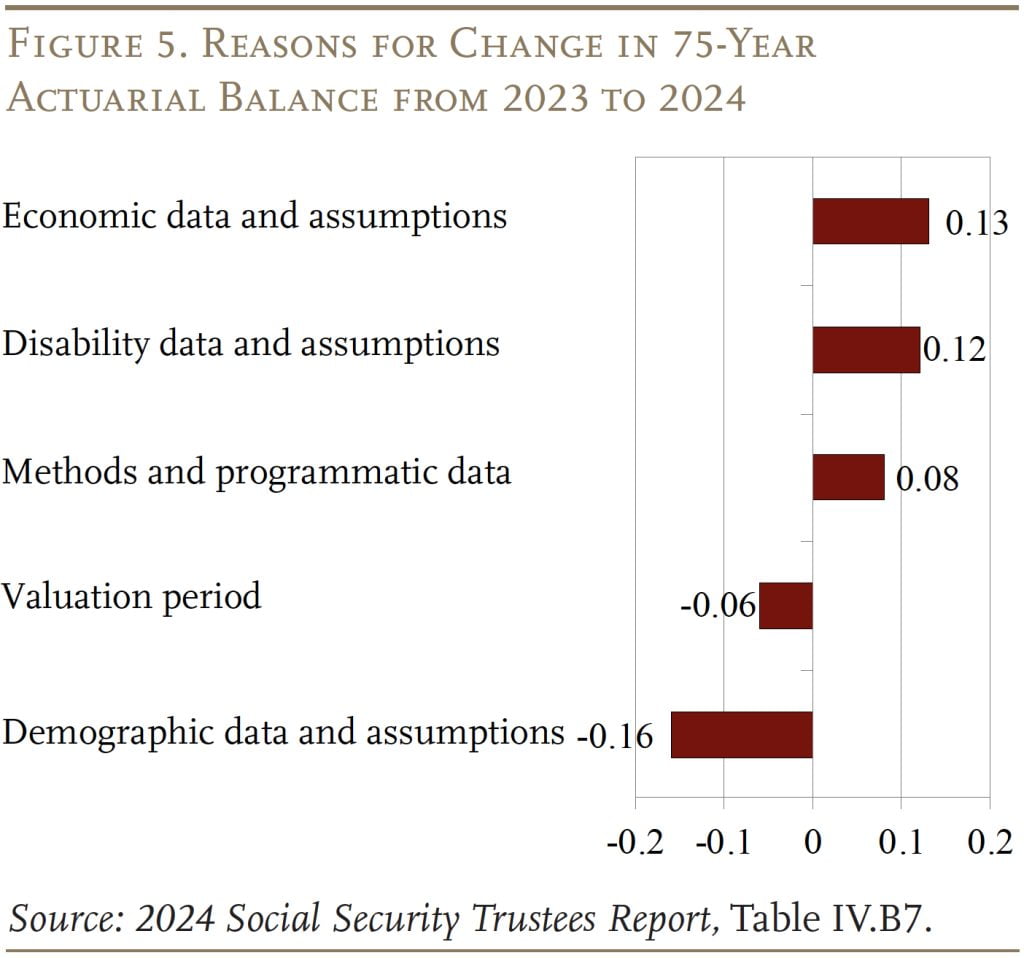
Economy. Greater-than-anticipated growth last year led to an increase in the assumed level of productivity growth over the projection period, and updated data on educational attainment led to higher assumed labor force participation. In addition, new data on the number and age of covered workers improved the actuarial balance.
Disability incidence. The DI incidence rate (new awards relative to the insured population) has continued to drop (see Figure 6), driven largely by the strength of the economy and a stricter process for awarding benefits on appeal.1Liu and Quinby (2023). In response, the Trustees lowered the ultimate rate for the projections. In addition, with a lower prevalence of disability, the model produced higher labor force participation and employment rates.
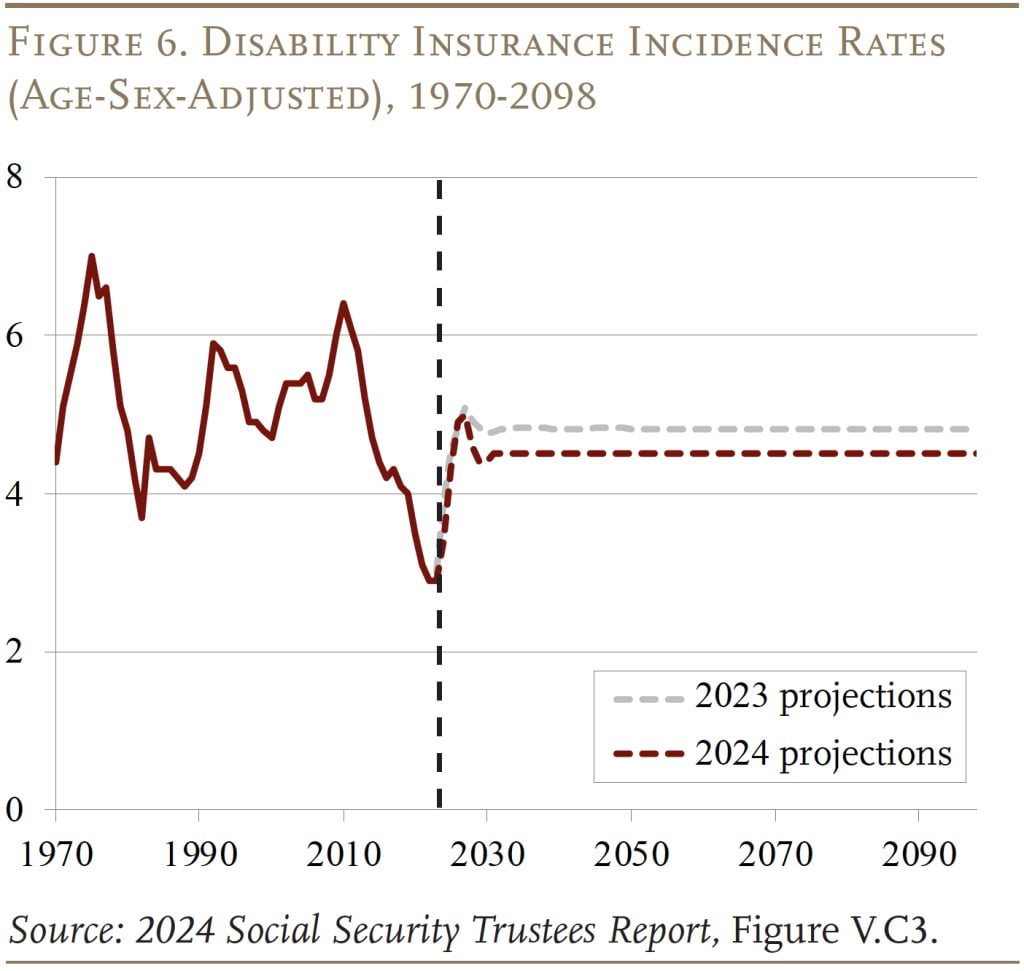
Fertility. The total fertility rate has been declining sharply (see Figure 7), and recent surveys of birth expectations show women planning on fewer children than in the past. This trend reflects a host of factors including lower marriage rates, high cost of childcare, concerns about economic opportunity, and lower fertility in countries from which new immigrants are arriving. In recognition that fertility is unlikely to rebound to previous levels, the Trustees reduced the ultimate rate from 2.0 to 1.9 children per woman, and moved up the date when the ultimate rate is achieved from 2056 to 2040. These changes decreased the actuarial balance.
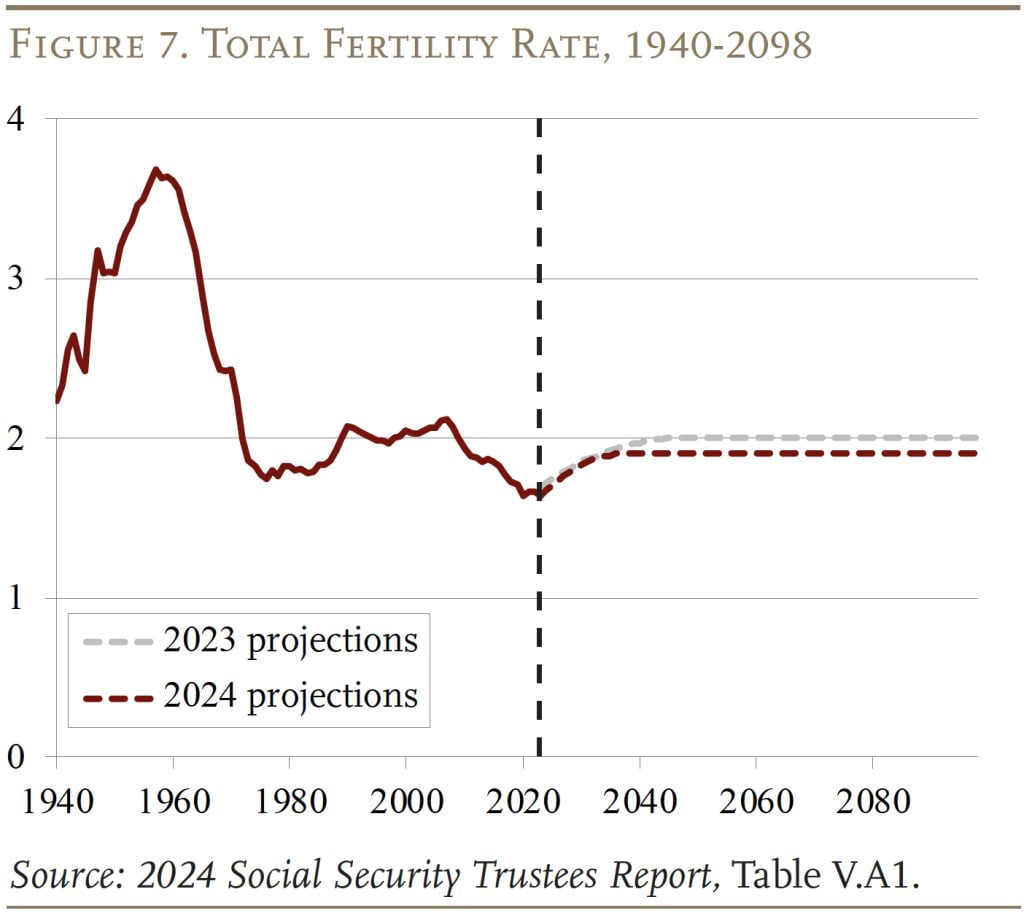
The focus here, however, is not year-to-year changes in the 75-year projections but rather the upcoming exhaustion of the OASI trust fund and the cost of delaying Congressional action.
Delay Has Real Costs
The depletion of the OASI trust fund is not news. Virtually from the day the trust fund began accumulating assets, the Trustees have projected its depletion. But time is getting short: whereas we used to have 68 years to figure out how to avoid depletion of the OASI trust fund, we now have 9 years (see Figure 8).
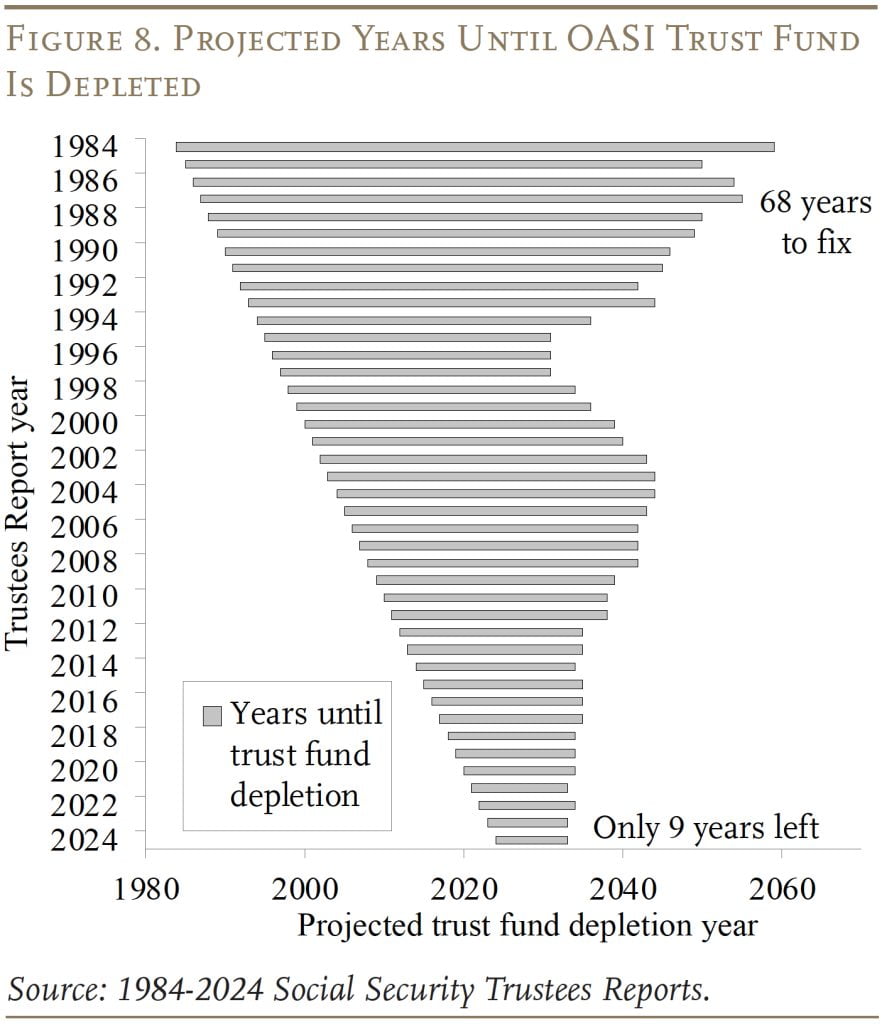
Failure to act has serious implications. It undermines Americans’ confidence in the backbone of our retirement system and causes some to claim their benefits early, hoping that those on the rolls may be spared future cuts. Equally important, delaying action means that some options disappear, the eventual changes must be more abrupt, and fewer of the current adult generations participate in the fix. The following discusses one of the options that disappears with delay, explores the impact on the allocation of costs across cohorts, and, so that we never find ourselves in this predicament again, argues that any financing package should include an automatic adjustment mechanism.
Investing the Trust Fund in Equities
One disappearing option is the chance to invest a portion of trust fund reserves in equities, an idea that – at last – appears to have considerable support. Since equity investment has higher expected returns relative to safer assets, Social Security would likely need less in tax increases or benefit cuts to achieve long-term solvency. Indeed, if Social Security had begun investing 40 percent of its assets in equities in 1984 or even 1997, the trust fund would not be running out of money today.2Burtless et al. (2017). Moreover, economists also argue that efficient risk-sharing across a lifecycle requires individuals to bear more financial risk when young and less when old, and since the young have little in the way of financial assets, investing the trust fund in equities is one way to achieve that goal.
The real world provides a convincing case that governments can invest in equities in a sensible manner. Canada has a large actively managed fund, follows fiduciary standards, and uses conservative return assumptions. In the United States, the Railroad Retirement system has also invested in a broad array of assets without interfering in the private market, as has the Federal Thrift Savings Plan, where the government plays an essentially passive role.
Investing trust fund assets in equities, however, requires having a meaningful trust fund. As noted, Social Security’s trust fund is quickly heading towards zero. If policymakers wait until 2033 to fix the system, recreating a trust fund would require a tax hike to cover both the program’s current costs and to produce an annual surplus to build up reserves. It is not clear that the political will exists to make such a move, and, indeed, with costs – as a percentage of taxable payrolls – scheduled to level off, it is hard to argue that today’s workers should pay more to build up a trust fund so that tomorrow’s workers would pay less.3Munnell and Wicklein (2023).
The good news is that, in 2024, Social Security reserves equal $2.6 trillion dollars, roughly two and a half times annual costs. Combining these balances with a 3.5-percentage-point increase in the payroll tax would produce a substantial trust fund over the next decade (see Figure 9). Yes, the annual surpluses – the shaded area – are slightly smaller than the surpluses that emerged from the 1983 legislation, but this time we are starting with S2.6 trillion, whereas in 1984 we were starting with zero. Investing a portion of these assets in equities could help cover costs over the next 75 years and beyond. But to take advantage of this option, Congress has to act sooner rather than later, before the trust fund hits zero.
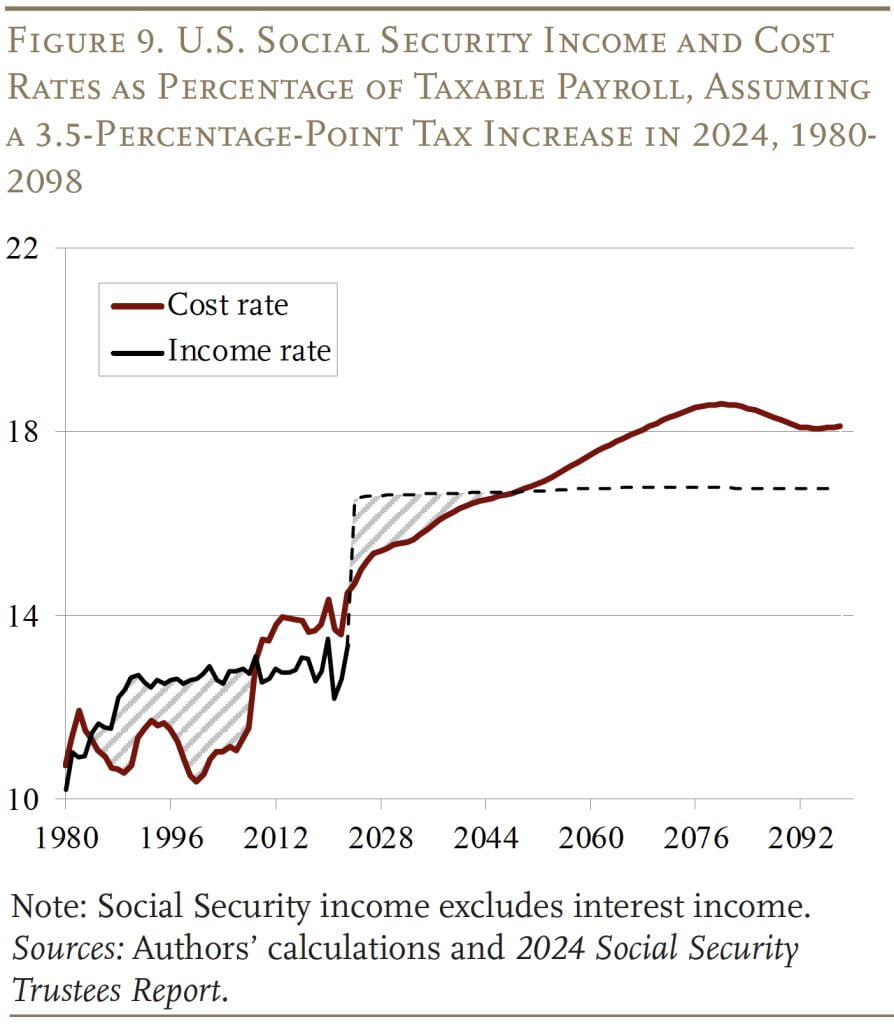
Distributing the Burden Fairly Across Generations
Some commentators suggest that delay raises the cost. That conclusion is simply not correct. The cost is the difference between Social Security’s cost and income rates, as shown by the two lines reported in Figure 1; costs and revenues do not change as a result of congressional inaction. The different numbers that commentators highlight simply reflect different 75-year projection periods – for example, 2015-2089 versus 2024-2098.
What is impacted by delay is the generations who will foot the bill. For example, if the change had been made in the early 1990s when a significant long-term shortfall first re-emerged, the Baby Boom would have shared more of the burden with subsequent generations. At this point, the youngest Boomer is age 60, so the Boomer cohort will not be affected by any increase in the payroll tax and they are almost certainly protected from any benefits cuts (see Table 3). The only way to extract a contribution from the Boomers would be to make some delay or cut in the annual cost-of-living adjustment to Social Security retirement benefits.
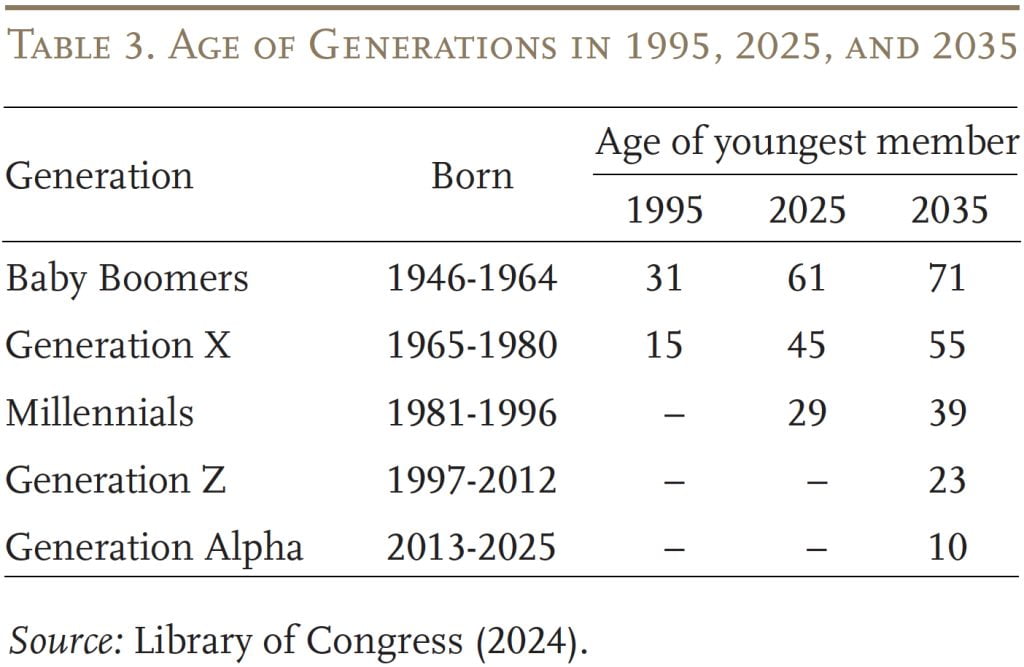
It is not only the Boomers, however, who are disappearing from the labor force. If Congress fails to act until 2035, the youngest member of Generation X will be 55. At that point, Gen Xers will contribute almost nothing in terms of additional taxes and will most likely be grandfathered from benefit reductions. The result of the good fortune accorded Boomers and Gen Xers is that Millennials and subsequent generations will have to pay the full cost of fixing Social Security to maintain 75-year solvency through 2098 which, with changes beginning in 2035, would require a tax increase in excess of 4 percent or a 25-percent reduction in all benefits (versus 21 percent if action were taken today). It is unlikely that such an outcome would be the result of a careful policy deliberation. It is capricious and unfair and gets worse the longer the delay.
Preventing Future Crises
One way to avoid repeated crises and restore confidence in the financial stability of the Social Security program is for any package of solutions to include a mechanism that automatically adjusts revenues and benefits if shortfalls emerge. As of the most recent OECD report on retirement programs, many countries have mechanisms that link the parameters of their programs to changes in either economic or demographic developments, and seven have automatic balancing mechanisms explicitly designed to ensure that the retirement plans are fully financed (see Table 4).
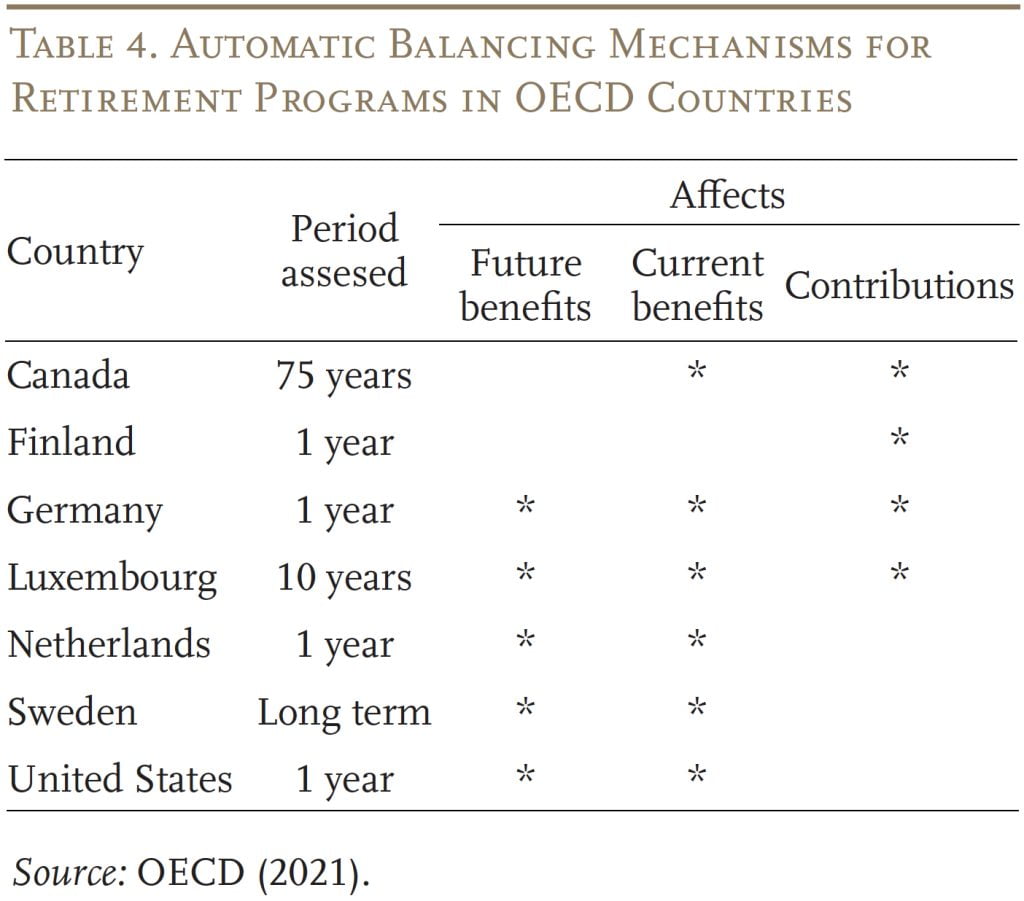
Interestingly, the United States is included on this list. We, in fact, do have a mechanism to ensure that the system is fully funded. When the trust fund is depleted, Social Security must cut benefits to the level of incoming revenues – hence, the projected 21-percent benefit cut in 2033. This mechanism, however, is a draconian way to spur action and does not seem very effective, except at creating great anxiety among older workers and retirees.
The Canadians have a much more civilized approach – perhaps one that could serve as a model for the United States. It is a backstop arrangement that is activated only in the absence of a political agreement. Mechanically it works as follows. Every three years, the Chief Actuary estimates the minimum contribution rate needed to finance the system over 75 years. If the required rate exceeds the legislated rate and policymakers cannot agree on a solution, the backstop kicks in. In that case, the cost-of-living adjustment is frozen, and contribution rates are increased by 50 percent of the difference between the legislated and the required rate for three years until the Chief Actuary’s following report. The mechanism thus avoids uncertainty about the system’s financial stability over time if policymakers fail to act.
The United States does not have to adopt the specifics of the Canadian backstop mechanism, but including some automatic adjustment in the face of inaction would improve confidence in the long-term stability of the Social Security program.
In short, fixing Social Security sooner rather than later would restore confidence in the nation’s major retirement program, give people time to adjust to needed changes, retain a number of options that are fast disappearing, and distribute the burden more equitably across cohorts. Moreover, to avoid future crises of our making, any financial fix should include an adjustment mechanism that automatically restores balance if policymakers fail to act.
Conclusion
The 2024 Trustees Report confirms what has been evident for almost three decades – namely, Social Security is facing a long-term financing shortfall that equals 1 percent of GDP. The changes required to fix the system are well within the bounds of fluctuations in spending on other programs in the past. Moreover, action needs to be taken before the OASI trust fund is depleted in 2033 to avoid a precipitous cut in benefits. Americans support this program; their representatives should fix its finances.
References
Burkhalter, Kyle and Karen Rose. 2024. “Replacement Rates for Hypothetical Retired Workers.” Actuarial Note Number 2024.9. Baltimore, MD: U.S. Social Security Administration.
Burkhalter, Kyle and Chris Chaplain. 2023. “Replacement Rates for Hypothetical Retired Workers.” Actuarial Note Number 2023.9. Baltimore, MD: U.S. Social Security Administration.
Burtless, Gary, Anqi Chen, Wenliang Hou, and Alicia H. Munnell. 2017. “How Would Investing in Equities Have Affected the Social Security Trust Fund?” Working Paper 2016-6. Chestnut Hill, MA: Center for Retirement Research at Boston College.
Chu, Sharon and Kyle Burkhalter. 2024. “Disaggregation of Changes in the Long-Range Actuarial Balance for the Old Age, Survivors, and Disability Insurance (OASDI) Program Since 1983.” Actuarial Note Number 2024.8. Baltimore, MD: U.S. Social Security Administration.
Clingman, Michael, Kyle Burkhalter, and Chris Chaplain. 2014-2022. “Replacement Rates for Hypothetical Retired Workers.” Actuarial Note Number 9. Baltimore, MD: U.S. Social Security Administration.
Liu, Siyan and Laura D. Quinby. 2023. “What Factors Explain the Drop in Disability Insurance Rolls from 2015 to 2019?” Working Paper 2023-7. Chestnut Hill, MA: Center for Retirement Research at Boston College.
Library of Congress. 2024. “Doing Consumer Research: A Resource Guide.” Washington, DC.
Munnell, Alicia H. and Michael Wicklein. 2023. “Should Social Security Invest in Equities?” Issue in Brief 23-14. Chestnut Hill, MA: Center for Retirement Research at Boston College.
Organisation for Economic Cooperation and Development (OECD). 2021. “Pensions at a Glance.” Paris, France.
U.S. Social Security Administration. 1983-2024. The Annual Reports of the Board of Trustees of the Federal Old-Age and Survivors Insurance and Federal Disability Insurance Trust Funds. Washington, DC: U.S. Government Printing Office.
Endnotes
- 1Liu and Quinby (2023).
- 2Burtless et al. (2017).
- 3Munnell and Wicklein (2023).







